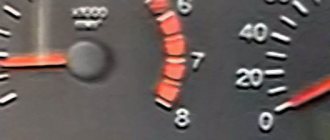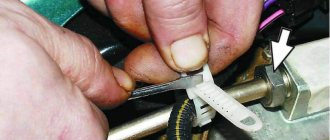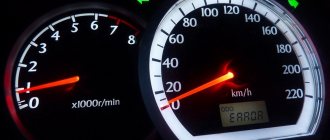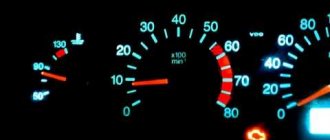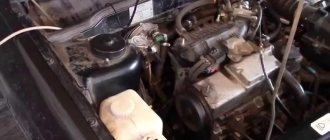Air flow sensor
If the IAC turns out to be serviceable, then you should check the air flow sensor.
To do this, you will also need a multimeter set to voltage measurement mode (in the range of up to 20 volts). Measurements are carried out as follows:
- turn off the engine and turn on the ignition;
- measure the voltage at the sockets used to connect the yellow and green wires;
- if the voltage value is in the range of 0.98 - 1.02 volts, then the sensor is working. If not, then action should be taken.
DMRV VAZ 2114
First, you can try to clean the sensor by blowing it with a composition for cleaning carburetors (in the form of an aerosol), although this does not always help. If after purging the voltage readings return to normal, then the “repair” was successful; if not, then the sensor will have to be replaced with a new, similar one.
Throttle valve
If after all the checks and measurements carried out above it was not possible to identify a malfunction, then all that remains is to check the condition of the throttle valve assembly. To do this, the part should be dismantled and then cleaned of dirt using cotton swabs. The cleaned part (or rather, all its pipes and tubules) is blown with compressed air using a compressor.
Cleaning the throttle VAZ 2114
Special attention should be paid to the channel that serves to remove gases from the crankcase. Before starting purging, it should be filled with a cleaning compound and allowed to stand for some time, after which the purging itself should be performed. This is caused by the extremely small diameter of the internal channel, as a result of which other methods of cleaning it are simply not available.
In addition to all of the above breakdowns, a breakdown of the DPKV sensor, as well as the Hall sensor, can also lead to “floating” speed. If they fail, the Check Engine light will light up on the car panel. If such a malfunction occurs, it is best to contact a service center, since special equipment is required to check these sensors.
Other reasons
Sometimes the engine may shut down due to a stuck idle air valve. Solving this problem is quite simple - you only need to adjust the throttle cable. True, the car’s performance will not be restored for a long time. But there will be enough time to get to the car service center.
If the car does not start when cold, then it is worth looking for a fault in the battery. Perhaps one of the terminals is not holding well. It is also worth resetting the ECU settings by turning off the power. After this, the on-board computer will reboot. This measure will be enough for several trips - then the system will accumulate enough information to start working normally, and the engine will most likely stall again.
Finally, if none of the above helps, you will need to pay attention to the injectors. Improper operation of this element is caused by:
- wear;
- clogging.
For cleaning, you should use a special liquid - WD-40.
Is the idle air control valve working correctly?
The IAC is checked by measuring the electrical resistance at the contacts - to diagnose the device you will need a tester (multimeter) set to the “ohmmeter” operating mode. To check the details:
- Let's turn off the ignition.
- Disconnect the connection block.
- Let's measure the resistance on contacts A - B and C - D of the device. The optimal readings of the device vary from 40 to 80 ohms.
- Let's repeat the measurements with contacts B - C and A - D. In this case, the multimeter should show “infinity” or an open circuit.
Any violation of the normal resistance values means a malfunction of the regulator. IAC failure is a common cause of floating engine speed at idle, and if a malfunction is detected, the device must be replaced. Before you begin dismantling the part, you must disconnect the negative wire from the battery. After installation, the new IAC is calibrated - the removed terminal is returned to its place, the ignition is turned on and after 5-10 seconds (there is no need to start the engine).
IAC failure is a common cause of floating engine speeds.
Diagnostics of the IAC sensor VAZ 2110
There are several ways to check the idle speed control. To check we need a multimeter. First, let's describe the simplest way:
IAC check method 1
- Disconnect the block and unscrew the sensor
- Turn on the ignition
- We connect the block to the removed sensor, the needle in it should extend. If this does not happen, then the sensor is faulty.
IAC check method 2
- Disconnect the negative terminal of the battery
- Using a multimeter, we measure the resistance of the external and internal windings of the IAC, while the parameters of contacts A and B, and C and D should be 40-80 Ohms.
- If the instrument scale is zero, it is necessary to replace the IAC with a serviceable one, and if the required parameters are obtained, we check the resistance values in pairs B and C, A and D.
- The multimeter should detect an open circuit
- With such indicators, the IAC is serviceable, and if they are absent, the regulator must be replaced.
IAC test method 3
- Disconnect the block from the sensor
- Using a voltmeter, we check the voltage - the “minus” goes to the engine, and the “plus” to the terminals of the same block of wires A and D.
- The ignition is turned on, and the received data is analyzed - the voltage should be within twelve volts, if less, then most likely there are problems with the battery charge. If there is no voltage, then you will have to check both the electronic control unit and the entire circuit.
- Then we continue the inspection with the ignition on, and analyze terminals A:B, C:D one by one - the optimal resistance will be about fifty-three ohms; During normal operation of the IAC, the resistance will be infinitely high.
Idling
Idling of a car is the operation of its engine when the gear is in neutral. At the same time, the fuel load, as well as the load on the engine, is minimal.
Idling is used in several cases:
- To “bleed” the oil after the car has been parked for a long time.
- To warm it up during cold weather.
- To keep the engine running for a long time without driving the vehicle.
Idling VAZ 2114
Engine idle operation looks like this: first, the speed quickly rises to 2,000 or even 2,500 rpm, after which it gradually decreases and stops around the 800 rpm mark.
This type of engine operation is absolutely normal. If, in idle mode, the VAZ 2114’s revolutions jump (either sharply increase or drop sharply, and the interval of “jumps” can be up to 1,500 rpm), then a malfunction has occurred in the engine system. In most cases, such a sharp fluctuation in speed leads to the engine stalling.
Idle speed control
The first thing you should check is the idle speed control. To do this, you will need a tester (multimeter) set to ohmmeter mode.
The check is performed as follows:
- turn off the ignition;
- disconnect the block;
- measure the resistance between contacts A * B and C * D of the regulator. If it is working properly, the device will show a resistance value in the range from 40 to 80 Ohms;
- measure the resistance between contacts B * C and A * D. If the regulator is operational, the ohmmeter will go off scale (on some devices an “open circuit” may be indicated).
Dirty IAC VAZ 2114
If the results obtained during measurements differ from those given above, then the idle speed controller is broken. By the way, its failure is one of the most common reasons why the idle speed of a VAZ 2114 injector fluctuates. If a breakdown is detected, the part should be replaced with a new, similar one (since the IAC is not a repairable device). Do not forget that before starting to replace the device, you should disconnect the battery ground terminal.
If the car stalls in neutral...
There are a lot of reasons why a VAZ 2114 with an injector may not work properly when cold. Among them:
- “dying” fuel pump;
- IAC malfunction;
- injector clogging;
- DTOZh malfunction.
IAC (idle air control) is one of the “favorites” of VAZ owners. In addition to stalling, its malfunction is indicated by unstable idle speed. While driving, the car may stall when you switch off the gear or release the gas. The regulator is checked with a multimeter, measuring (with the ignition off) the resistance at the outputs. On pairs of terminals AB, CD there should be ≈ 53 Ohms. There is infinity between AC and BD. If this is not the case, the IAC needs to be cleaned or replaced.
Injector clogging is common due to fuel of questionable quality at half of the country's gas stations. Often the problem is solved by purging with an injector or carburetor cleaner. It's worse if the injectors are clogged. Sometimes it is possible to clean them manually using special chemicals, but more often only ultrasonic cleaning in the service or replacement can help.
The fuel pump does not always “die” immediately. More often than not, problems grow gradually. Listen to its sound when you turn the ignition. If it becomes louder or quieter than usual, this is a signal. Fuel pump malfunctions manifest themselves in different ways, to the point where the car cannot be started. If the car stalls in neutral or when braking, but operates normally in other modes, the fine filter mesh may be clogged.
Optimal engine speed VAZ
Sooner or later, everyone asks the question: driving at what speed is optimal for normal operation of a car engine? There are two opposing sides to this issue: supporters of driving at low engine speeds and supporters of driving at high speeds. VAZ cars have gasoline engines with a maximum speed of 5500 rpm. However, both low and high speeds each have their own negative factors that affect engine performance.
Fans of driving at low speeds cite fuel economy as the main argument. All instructors in driving schools force their students to drive at low speeds (their interest is precisely in saving more fuel). Then these students graduate and begin to drive themselves at engine speeds of up to 2000. However, they forget about one thing: the instructor at the driving school does not care at all about the engine life of a government-owned car. And when you drive a car that you bought with your own blood and sweat, you begin to think: “How can I drive so that the car lasts longer? ". And here it turns out that low speeds have a significant disadvantage: engine lubrication is worse at these speeds. In order for the lubricant to circulate well in the lubrication system and to be sprayed onto the components of the lubrication system, revolutions of more than 2500 rpm are required. That is, at low speeds, engine lubrication is significantly worse. Another disadvantage of low revs is poor charging of the battery, since the lower the revs, the less power the generator provides. It won’t be a very pleasant surprise to walk up to your car in the cold morning and not start it because the battery is not fully charged.
Now let's look at driving at high speeds (4000 or more). At such speeds, the lubrication pressure is high, lubricant circulates through the system, but too intensely - because of this, the lubrication channels may become clogged (especially if the engine oil has not been changed for a long time). The second negative factor is engine overheating. Even if everything is in order with the engine cooling system, it will not always withstand driving at high speeds for a long time. Well, if there are any problems: the thermostat does not open completely, the coolant level is low, the cooling system is clogged, then engine overheating is guaranteed. Antifreeze will begin to boil away, the cylinder head gasket may burn out, or the engine may even jam. In general, high speeds are also not an option. We are not even talking about the fact that when driving this way, fuel consumption is much greater than during normal driving.
The best option for VAZ cars is to drive at a speed of 2500-3500 rpm; it is the most optimal for engine operation, for the cooling system and in terms of fuel consumption.
Adjusting the injector on a VAZ-2114
Today, the carburetor on gasoline engines, so familiar to us, is gradually being replaced by a more advanced mechanism - the injector. The impetus for the development of a new fuel system back in the 60-70s was the need to reduce harmful emissions into the atmosphere and reduce the harm from exhaust emissions. The emergence of new injection engines has made it possible to successfully solve this problem.
Advantages
But reducing emissions is not the only advantage of injectors compared to an older carburetor. There are many more advantages:
- firstly, the air-fuel mixture is dosed perfectly under the control of the computer, which can significantly reduce vehicle consumption. In practice, an injection engine is 20-30% more economical than its carburetor predecessor;
— secondly, the toxicity of exhaust gases is reduced significantly. This was largely possible thanks to the use of special sensors;
— thirdly, the power of the power unit increases by an average of 10-12%. This is due to a clear setting of the advance angle (here the electronics come into force), as well as an increase in the quality of filling the cylinders;
— fourthly, the dynamic properties of the car are significantly improved, it becomes more playful and responsive during acceleration. The electronics respond perfectly to the driver’s commands, accurately and efficiently adjust the air-fuel mixture;
- fifthly, the car becomes much easier to start at any temperature (carburetor engines could rarely boast of this).
It is important to note that the operation of the system directly depends on the program flashed into the ECU and information received from numerous sensors. Thus, the following controllers take part in the operation of the system - throttle position, mass air flow, crankshaft position, coolant temperature, detonation and oxygen
When to make adjustments?
Despite its reliability, the injector is not a perfect system. There are also possible failures here that the car enthusiast can correct and correct. For example, during operation, unpleasant “dips” of the engine may appear, fuel consumption will increase, and “floating” idle speed may occur. All this may be evidence of incorrect injector settings.
Many people believe that the injector is a completely maintenance-free unit that is difficult to adjust. Car enthusiasts complain that it is impossible to change the advance angles, adjust the supply of the air-fuel mixture, and so on. But with certain knowledge, everything is not so tragic. You can still make some adjustments to the VAZ-2114 injector yourself.
First, you need to make sure that all sensors are in good working order and clearly perform their task. Only in this case can you start setting up. There are many known cases where car enthusiasts spent several hours on adjustments in vain. As a result, the cause of all the problems turned out to be one of the sensors. If everything is fine, continue checking.
Turn on the ignition and wait until the injector is pumped with fuel. At the same time, the malfunction lamp should light up on the instrument panel (don’t worry - this is how it should be). Turn on the on-board computer and wait for it to perform diagnostics. In this case, all the main parameters of the car should be displayed. If no errors are found, continue further.
Check the throttle device. Turn on the ignition and use a multimeter to measure the voltage of the sensor and the on-board network. At the same time, look at how much the throttle has opened. If there are no problems, the voltage level of the sensor should be about 0.5 V, and the on-board network should be about 12 Volts. As for the throttle valve, it should be open to one percent. If after the test these parameters are obtained, then there is no need for adjustment.
It is advisable to carry out a similar throttle check with the gas pedal fully pressed. In this case, the voltage at the sensor should be about 4.5 Volts, the throttle opening should be 90-100%.
Chip tuning
Please note one nuance - to carry out a full adjustment, it is advisable to have a laptop on hand, a special adapter for connecting to the diagnostic connector, as well as configuration software. In this case, you can connect to the “brain” of the car and make the necessary changes. Moreover, using a computer, you can personally see all the parameters set at the factory and make their adjustments. Naturally, acting at random is dangerous - you must clearly understand what you are changing, why and what results you plan to achieve in the future. If you wish, you can find ready-made programs on the Internet with the necessary settings, which you can simply download through the car’s ECU.
Why does the car accelerate on its own when idling? Learning to make diagnostics
Sometimes you can hear questions about why the car accelerates on its own at idle? This can manifest itself at the most inopportune times, and the strength of the “self-reversal” often varies. In some cases, the speed may fluctuate slightly between 800-1200 rpm. In other situations, the car can scare others at traffic lights, spontaneously raising the speed to 4000-5000. But, regardless of the size of the jumps, it is advisable to fix the problem as soon as possible. This will avoid many unpleasant moments, including increased fuel consumption, as well as increased wear of parts.
Why does the car accelerate on its own when idling? To answer this question, you will need to conduct a detailed diagnosis. There are many reasons for this behavior of the car, so you will have to take turns checking all the parts whose malfunction can lead to such jumps. You should start with the simplest options and end with the most complex elements. It’s not bad if it is possible to conduct computer diagnostics. This will simplify the troubleshooting process.
Replacing the Throttle Position Sensor on a VAZ 2110
Using a Phillips screwdriver, unscrew the two sensor mounting bolts, disconnect the block and remove the sensor.
If traces of rust or oxidation are found on the rod, which regulates the speed, it is necessary to clean it with penetrating lubricant.
Next, a new sensor is installed, the block is connected and the idle speed is checked.
Adjusting XX on the carburetor
Owners of cars with a carburetor dosage of the air-fuel mixture have probably more than once encountered the need to perform the process of adjusting this device. Strictly speaking, there is nothing complicated in this procedure, and this is one of the few advantages of a carburetor over an injector.
Before you start adjusting the idle speed, prepare the minimum required set of tools (you will need a screwdriver and wrenches, the specific sizes of which depend on the type and model of the carburetor). The principle of adjustment is to set the number of idle revolutions at which stable operation of the power unit at minimum crankshaft speeds will be ensured.
Since the vast majority of carburetor cars operated in our country are AvtoVAZ products, it makes sense to consider the features of adjusting the idle speed on Solex carburetors - they are installed on these cars.
Having a tachometer will be of great help, with the help of which it is convenient to monitor the actual rotation speed of the HF, but not all models have this device installed as standard. In particular, on younger models, which are currently not produced, there is no tachometer (“penny” family -2101/21011/21013).
However, in this case there is a way out - connecting an external device to the on-board electrical network. In principle, many drivers do not look at the tachometer readings, guided by hearing and other external signs when determining the required crankshaft speed. However, it is possible to set the idle speed most accurately only on cars with a tachometer.
So, the procedure for adjusting the idle level on a carburetor engine is performed in the following sequence:
In most cases this is sufficient, but sometimes the adjustment process requires additional steps. The reason is that by turning only the screw for the amount of air-fuel mixture, it is not always possible to achieve stable operation of the engine at minimum speed. Then you need to try to “play” with the mixture quality screw.
Usually there is a plastic plug installed on it, which will have to be removed. The problem is that you can't do this with your bare hands. Usually a self-tapping screw is screwed into the plastic and then pulled out along with the plug. The second method is to pierce the plastic with an awl, and a hook or something similar can be inserted into the resulting hole.
Before adjustment work, by twisting the quality screw, you must make sure that the ignition timing is set correctly and that the high-voltage wires and spark plugs are in good condition. It is also necessary to make sure that there is no air leakage from the outside. Get ready for the fact that you may have to make fine adjustments more than once.
Algorithm for setting the XX fuel assembly quality screw:
How to eliminate high speed when cold
Eliminating the problem of high speed when starting a cold engine always depends on the reasons. Accordingly, depending on the failed unit, it will be necessary to carry out a number of checks and repair measures.
First of all, check the condition of the throttle valve and its operation. Over time, a significant amount of carbon deposits accumulates on its surface, which should be removed using a carb cleaner or other similar cleaning agent. As they say: “In any unclear situation, clean the throttle valve.” The rod may also jam in the air channel. Depending on the design of a particular engine, their control system can be mechanical or electronic.
If the design involves the use of a drive cable, then it would be a good idea to check its integrity, general condition, and tension force. When the damper is controlled using various electric drives or solenoids, it is worth checking them with a multimeter. If you suspect a malfunction of any of the sensors, it should be replaced with a new one.
If there are corresponding symptoms, it is imperative to check the fact of air leaks in the intake tract at the connection points.
It is also worth paying attention to the cooling system, in particular its elements such as a thermostat and pump. You can accurately determine the incorrect operation of the thermostat by the poor operation of the stove.
And if there are problems with the pump, leaks or extraneous noise will be visible.
Conclusion
It is necessary to understand that short-term high speeds on a cold engine are normal. And the lower the ambient temperature, the longer the increased speed will take place. However, if the time exceeds approximately five minutes or more, then this is already a reason to perform diagnostics. First of all, you need to scan the memory of the electronic control unit for errors in it. These could be errors in the idle speed controller or the sensors listed above. If there are no errors, you need to perform additional mechanical diagnostics according to the recommendations described above.
Other reasons
In extremely rare cases, even after repairing and replacing all the sensors listed above, high idle speeds may still remain.
The reason here may lie either in defective devices installed instead of failed ones (unfortunately, this sometimes happens with domestically produced parts) or in the installation of sensors of a model different from the original one.
In the latter case, you should pay attention to the idle speed sensor, since they are produced in two variations - an earlier and a later one (which is installed on 2114).
If, instead, a sensor from an early series was installed, which has an adjusting screw, then it should be fine-tuned by carefully turning the head of the screw and at the same time observing the state of the revolutions.
When releasing the gas, the speed is increased or “freezes”: common malfunctions
Let's start with the fact that on many cars with an injector, the ECU raises the speed while the internal combustion engine is warming up. This is necessary to ensure that the power unit operates stably after a cold start.
However, after the temperature rises, the control unit reduces the idle speed, bringing it to normal. On many cars with a carburetor, the driver independently increases the speed during warm-up, using the so-called “choke”.
Moreover, after the engine is warmed up, the normal idle speed is, on average, 650-950 rpm. If you press the gas and release the accelerator, the speed should increase, and then decrease again to the specified values.
Also, a situation often arises when the speed drops slowly or is constantly kept at around 1.5 thousand rpm, 2 thousand revolutions, etc. Naturally, in such cases, consumption increases and the internal combustion engine wears out more, which indicates the need for diagnostics.
So, let's start with common carburetor problems. Often the engine speed does not drop due to problems with the throttle valve. For example, when the driver steps on the gas, the throttle must be opened wider to allow more air to enter the cylinders to burn fuel. After the gas pedal is released, the throttle closes and the speed decreases.
If the damper does not close completely, an over-enriched mixture enters the cylinders, and the speed is increased. The cause may be severe contamination of the throttle assembly or damage to the valve itself (deformation). First you need to clean the damper; carburetor cleaning liquid is suitable as a cleaner.
We also note that the damper does not close tightly even when the drive cable is worn out. In this case, the cable must be replaced. On carburetor cars, engine speed often does not drop even if the gasket between the carburetor and the cylinder head has failed. The culprit may also be an intake manifold that is damaged.
It should be noted that
after cleaning the carburetor
and the fuel system, the engine speed slowly drops due to a failure in the adjustments of the idle system itself. In other words, after any manipulations with these nodes, you should separately configure and
adjust carburetor
The main task is to find the correct ratio of fuel and air. Often, a high level of fuel in the carburetor float chamber also leads to increased speed. The check should begin with the needle valve.
Now let's move on to the injector
Please note that on many injection cars, after cleaning the throttle valve, the assembly also needs to be additionally “trained”. As for problems, the injection system itself is more complex, that is, there are more reasons for high speeds compared to a carburetor
As a rule, problems with speed can be caused by problems with both mechanical elements and electronic components. In the list of main malfunctions, experts highlight malfunctions of the coolant temperature sensor, which is installed in
cooling system
In simple words, if the specified sensor gives an incorrect signal, the ECU considers that the engine is cold and activates the warm-up mode. In this case, the control unit raises the speed so that the power unit operates stably and reaches operating temperature faster.
Also, problems with speed may begin due to malfunctions and malfunctions
RXX
(idle air control). It also happens that the throttle cable gets stuck and becomes wedged. The spring that closes the throttle valve may also become stretched or damaged.
Special attention should be paid to gaskets, since air leaks can lead to disruption of mixture formation. This means that you need to separately inspect manifold gaskets, injector seals, etc.
Where are the IAC and TPS sensors located?
So, first, let's check the IAC sensor. It is located on the throttle assembly below the TPS sensor. Dismantling it is very simple - remove the block from the sensor and use a Phillips screwdriver to unscrew the two bolts securing it. Then we pull out the sensor or perform diagnostics on it, read about this below.
The throttle position sensor is located above the IAC and is also secured with two bolts. It unscrews quite easily; there is no need to remove either the pipe or the throttle itself. Disconnect the block, unscrew the two bolts and pull out the sensor.
To make sure that the problem with high speed is really in one of these sensors, and maybe in each other at once, you should diagnose them.
What is high engine speed
The rotation of the engine depends on the amount of air supplied. The air mixture enters through the throttle valve, then passes through the intake manifold into the cylinder block. The throttle position sensor (TPS) transmits data about the opening angle to the ECU. The computer calculates the amount of air entering and determines how much fuel to supply to create the working mixture. Accordingly, high speeds arise due to incorrect calculation of the ECU or excessive air entering the engine.
During normal engine operation during startup and operation without load, i.e. at idle speed, the speed is not high: up to 600 - 1000 per minute. The readings are displayed on the tachometer. It is permissible to rotate the motor at high speeds, 1100 - 2500 rpm, “cold” in winter for 10 seconds. During this time, the engine will warm up the oil and coolant to an operating temperature of +80℃…+90℃. The motor will become noisier.
If the tachometer needle does not decrease for a long time, you need to look for the reason why the speed is high.
https://www.youtube.com/watch?v=nfg_O5KOhsk
Similar article Do-it-yourself repair of 402 ZMZ engine
Diagnostics of TPS VAZ 2110
To diagnose the sensor we need a voltmeter.
- It is necessary to turn on the ignition and check the voltage between the slider contact and the minus with a voltmeter. The voltmeter should read no more than 0.7 V.
- Now you need to turn the plastic sector, thereby completely opening the damper, then measure the voltage again. The device must show at least 4 V.
- Turn off the ignition and disconnect the connector from the sensor. We check the resistance between the slider contact and some terminal.
- Slowly, turning the sector, monitor the voltmeter readings. Make sure that the needle moves smoothly and slowly; if you notice jumps, the throttle position sensor is faulty and must be replaced.
Symptoms of TPS malfunction
- Deterioration of vehicle dynamics
- Floating idle speed
- Jerking during acceleration
- High idle speed, car does not slow down
- The engine may stall at idle
If one or more of these symptoms are detected, the sensor should be checked and diagnosed in the manner described above.
Floating speed on the carburetor
On carburetor versions of the VAZ 2114 there is no electronic control unit as such. But this does not mean at all that the problem of floating speed is not alien to him.
Tachometer with high speed
Floating speeds do not occur as often as in the case of an injector, but still. The reasons, as well as troubleshooting methods, vary.
- The idle speed is set incorrectly, or it got lost during operation. In such a situation, the setting shifts to combining the fuel-air mixture. Here you will need to adjust the speed to the range of 800-900 units.
- The solenoid valve is faulty. The engine will only run if the choke is pulled out. If you remove it, the engine will immediately stall.
- The idle jet or channels are dirty. In such a situation, the fuel lacks air. Clean the jet and the problem will go away.
- Excessive air is sucked in. The mixture becomes leaner, so the engine sputters and stalls.
- The level of gasoline in the float chamber increases or decreases.
- The air filter is clogged. The problem is solved by simply replacing the element.
If engine vibration occurs at idle speed of the VAZ 2114, there is no need to worry. It's all about the design of the engine. A similar phenomenon is typical for carburetor engines during cold starts. The engine just needs to warm up to the optimal temperature, after which the vibrations disappear.
https://youtube.com/watch?v=p3TpjbZBjo8
The reason for the vibrations is the air-fuel mixture that the carburetor prepares before entering the combustion chamber. Low temperatures lead to inefficient combustion of the mixture. Hence the “shaking”.
Although it is not uncommon for vibrations to occur due to the cushions, that is, the engine mounts on which it is mounted. When they wear out, vibrations are possible. Moreover, this does not depend on what type of engine is used - injection or carburetor.
You should always pay attention to the floating speed of the VAZ 2114 and not wait for the problem to manifest itself in some other way. If you delay in identifying the causes and eliminating faults, repairs can be much more expensive.
Sources
Mass air flow sensor
After IAC, the air flow sensor should be checked. In addition to problems with idle speed, the following symptoms will be detected: failures when pressing the gas, increased fuel consumption, loss of power. To diagnose the sensor, disconnect the chip from it, while carefully monitoring the operation of the engine. If it breaks down, an emergency operation mode is activated, which already includes average indicators. Therefore, if the engine operation does not change, this indicates a malfunction.
Try treating it with cleaner and putting it back in place. The sensor is sensitive and can malfunction at the slightest contamination.
The main reasons for high speed
As a rule, high speeds of the VAZ 2114 are caused by one of the following malfunctions:
- the air filter is clogged;
- the gas sensor (throttle position) has failed;
- idle speed sensor is broken;
- The air flow sensor has failed.
In addition to the reasons mentioned above, increased speeds can be caused by simpler things, for example, a broken throttle cable. Such problems can be detected and eliminated during the initial inspection, and therefore we will not dwell on them and will talk about checking and replacing sensors.
The cause of a stalled engine is a power supply failure
In this type of problem, 3 reasons may be involved:
- Poor contact with the terminals of the new battery;
- Detection of poor contact or breakdown along the entire length of high-voltage wires;
- The appearance of malfunctions in the generator or ignition coil system of the car.
If the problem lies in damp high-voltage wires, then it is best to replace them completely along with the battery contacts. If the terminals make poor contact, you need to carefully clean them with sandpaper and try to reconnect them.
If the generator is found to be inoperable, the problem usually boils down to problems in the following parts:
- Broken timing belt;
- There is a malfunction inside the housing of the unit itself.
A problem with the generator is easily detected when the corresponding indicator on the dashboard turns on. In addition, if there is insufficient energy supply, the backlight of the on-board panel will gradually fade, and a set of other diagnostic sensors will show incorrect values.
From the list of reasons that are directly related to the car engine, you need to move on to problems that arise in the fuel and air supply systems, as well as malfunctions of components responsible for exhaust gas removal.
Ignition coil
